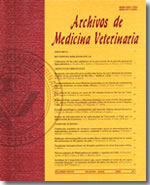Variation of infestation intensity with infective stages of the isopod Ceratothoa gaudichaudii in farmed salmon in the south of Chile
Main Article Content
Abstract
The study was carried out at a salmon farm located on Guar Island (42°, 41’S.; 73°, 01’E.), Xth Region, Chile. 500 salmon (Salmo salar) were sampled randomly from an isolated cage every three months. On each occasion the number and the size of the isopod parasite Ceratothoa gaudichaudiisettled in the oral cavity and gills were determined.
Prevalence ranged from 33.4% to 98.8% in the 16 months of the assay. The highest number of infective stages (mancas) of the parasite were found in spring and during the summer; this produced the increment of small size parasites in autumn and winter. The number of medium and large size parasites increased during the summer months.
The importance of wild fish, and specially of Trachurus murphyi, as the normal host of C. gaudichaudii and its role as a main source of infestation for cultured salmon is discussed.

